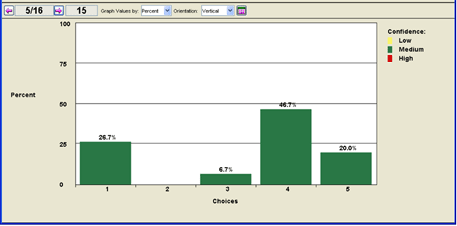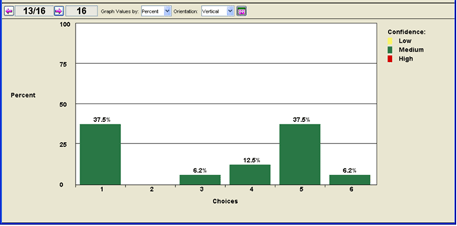December 2005 // Volume 43 // Number 6 // Tools of the Trade // 6TOT4
The Use of Personal Response Transmitters in Extension Settings
Abstract
Personal response transmitters (PRTs) facilitate
effective education by encouraging audience participation and providing the
educator with immediate indication of audience comprehension. Their use in
an IPM training session in Missouri provided measures of teaching impact,
audience knowledge base, and direction for discussion activities. Lessons
learned from initial activities taught that things such as room setup, random
distribution of the PRTs, question formation, technical assistance, and familiarity
with possible responses were critical to their successful use.
Introduction
Audience participation enables adults possessing knowledge from experience to influence teaching sessions. Because much adult Extension education does not involve testing, participation also serves as an informal measure of comprehension. Unfortunately, a dominant participant can obscure the educators' understanding of the needs and comprehension of the group as a whole.
The use of personal response transmitters (PRTs) can facilitate audience participation. This article details how personal response transmitters were used in an Extension program in Missouri and relates lessons learned.
Description of PRTs
PRTs tend to resemble TV remote controls. The PRTs we used, from Interwrite PRS, contain 10 buttons for numeric input. Each participant receives a PRT with a unique code to identify and record responses. The PRTs transmit, via a receiver, responses from the users to a computer that records and displays the responses.
Before a session, the instructor creates a participant roster, a response map, and questions with multiple answers. The roster links the responses to individual PRTs. The response map, displayed during the instructor-specified response period of each question, indicates if an individual PRT's answers have been received by the computer by changing color. The questions and possible answers can be viewed directly from the Interwrite program or within a PowerPoint presentation. If integrated into PowerPoint, the questions can be dispersed among teaching slides.
At an educational session, the instructor sets up the receiver and issues a transmitter to each participant. After a question has been displayed, participants point their transmitter toward the receiver and transmit their response. After the specified time for responding to a question, the results are graphically displayed for the audience. At this time, the instructor learns of the audience comprehension and can direct discussion according to that knowledge. A session may contain as many questions as desired by the instructor.
Responses are stored in a database so that summary statistics or statistical analysis can be conducted. Summary statistics show how many of the respondents answered in a certain way. Because each response is linked to each PRT's code, statistical analysis or correlations could be performed to see if certain participant characteristics (e.g. age of respondent or size of farm) explain their responses.
Use of PRTs in IPM Group
The use of PRTs at an IPM meeting in the winter of 2005 illustrates one use of the technology for educational purposes. The meeting involved presentations by three scientists and an economist. After the presentations by the scientists, an agricultural economist interacted with the group using the PRTs.
We familiarized the participants to the PRTs by asking them to respond to several simple questions. During this time, each person was instructed where to point the PRT for best transmission of their response and how to confirm that their response was received. We then asked questions about their pest scouting practices. Figure 1 shows the responses we received to the question "During the last growing season, I scouted (or had someone scout) my soybean fields: 1) daily, 2) several times a week, 3) weekly, 4) every 2 weeks or 5) rarely or never."
Figure 1.
Results to Soybean Scouting Question

This was followed by a question regarding their scouting intentions for the 2005 growing season (Figure 2). The two graphs viewed successively indicated that change was anticipated. This change became a point of discussion. Why were they planning to scout more frequently? How were they going to accomplish this? What resources did they have or need to scout?
Figure 2.
Soybean Rust Scouting Question

The questions on scouting were followed by questions asking the participants to identify diseases from pictures of soybean diseased leaves. One hundred percent of the participants correctly identified frogeye leafspot, while only 37% correctly identified Asian soybean rust. Both diseases had been covered earlier in the day. The benefit of this type of question is that without the use of the PRTs, those who did not know how to identify rust would have remained quiet, perhaps one person would have correctly answered, and the instructors would have assumed that most of the group knew the correct answer.
The PRTs gave the audience the freedom to be wrong without embarrassing themselves and, thus gave the educators immediate opportunity to address the problem. Given the response to the rust ID question, we modified the agenda of the workshop to allow the pathologist to conduct a "mini lesson" on correctly identifying rust.
Last, the economist covered how to use partial budgets to evaluate IPM strategies. This lesson was followed by questions regarding the cost and return implications of various management strategies for rust. One question asked the participants to give their opinions of whether spraying a field infected with rust would "1) increase costs, 2) decrease costs, 3) increase revenues, 4) decrease revenues, 5) increase costs and revenues, or 6) none of the above." The wide variety of responses permitted a discussion of the concepts of partial budgets within a relevant context where the participants had already made an assessment. Each participant was able to have his or her answer either affirmed or challenged without being publicly exposed.
Figure 3.
Graph of Spray Partial Budget Question

Lessons Learned in Making Use Successful
The following lessons learned in Missouri have made the PRTs more successful.
-
We purchased an extendable tripod that allowed us to put the receiver above the projection screen in the front of the room so everyone could see it.
-
Distribute the PRTs randomly so that people can't guess the serial number of other participants.
-
Test questions before using them with participants.
-
While learning the technology we had an assistant operate the PRT while an educator taught.
-
Graphs show multiple choice number rather than actual possible answers. Have a printout of the choices with their corresponding number so that you know immediately what response matches each number.
